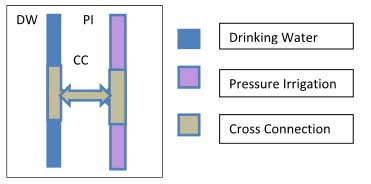By Kim Dyches
Following the recent news coverage about communities boiling their water, water customers may want to know if this contamination could have easily been prevented. The answer is YES. These contamination events were the result of a cross-connection between someone’s pressurized irrigation system and the culinary water line into their home.
Contaminated water entering drinking water systems presents serious health risks. Secondary irrigation water contains many organisms such as E. coli and fecal coliform that can cause disease and or even death, especially for the elderly, hospital patients, infants, or anyone with a compromised immune system.
It is difficult to get contamination into a water system because the water mains are generally pressurized to around 60 pounds per square inch (psi). There are two ways that contamination can enter the system:
- Back pressure: the water pressure of the contaminated water is higher than the water main pressure.
- Back siphonage: negative pressure creates suction that pulls contaminated water into the system.

Cross-connections are often the source of this kind of backflow contamination. A cross-connection is a physical connection between a potable source and a non-potable source of water. The recent drinking-water contamination events in Syracuse and Clinton were caused by connections between a pressure irrigation line and a drinking water line. Other examples include improper lawn irrigation connections to a culinary water system, or improper connections at a commercial or industrial facility between the culinary water system and the fire suppression system. A single cross-connection can contaminate an entire water system.
The Division of Drinking Water (DDW) assists water systems in the development of cross-connection control programs to protect public drinking water. In addition, the Drinking Water Board has established rules that govern the certification of backflow technicians to test and install backflow prevention assemblies.
When you receive a notice from your water system to boil your water, you shouldn’t use the water for drinking, food preparation, brushing teeth, ice made from tap water, and water for pets. Bathing or showering is not advised, especially if you have open cuts. If the water has chemicals in it, boiling the water won’t remove most of those contaminants and other methods must be used to remove the contamination. You should discard anything that was made using drinking water and drain your hot water heater.
Be aware that if a neighbor connects their drinking water line to the pressure irrigation line, he or she could potentially contaminate your water and put your family at risk. The best way to ensure that doesn’t happen is to notify the water department if you see someone digging on their water or sprinkler line and have someone from the department come look at it.
As we enter the season where we are watering our lawns and try to keep our yards beautiful, be mindful of the dangers. Be proactive in letting water officials know if you observe digging on sprinkler lines in your neighborhood. Have them come and inspect it. If we all work together, these problems can be minimized and hopefully we can avoid having to boil our water.
Want to know more? Check out our fact sheet on boil water notices and information from the American Backflow Prevention Association about cross-connection control.

I am the Field Services Manager for the Division of Drinking Water. I have been in the water industry for 30 years. I am adjunct faculty at Utah Valley University and have taught several courses on subjects relating to water.
